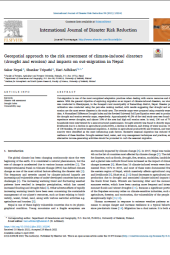Geospatial Approach to the Risk Assessment of Climate-induced Disasters (Drought and Erosion) and Impacts on Out-migration in Nepal
Summary
The study focused on migration patterns as a response to climate-induced disasters in Khaniyapani, Nepal. The researchers employed the pair-wise ranking method to prioritize disasters, revealing drought and soil erosion as the most severe issues. Severity maps were created using remote sensing data, depicting 46.2% of the area experiencing severe drought and 10% with high soil erosion rates. Interviews with 100 households were conducted, indicating that drought directly harmed livelihoods by reducing agricultural productivity, livestock, and water sources. Among these households, 64 practiced seasonal migration, primarily driven by declining agriculture, livestock, and water availability. This excessive migration has weakened family resilience. To address this, the study recommends promoting techniques for drought-resistant land, water, and crop management, along with alternative income-generating activities, as strategies to mitigate the need for seasonal migration.
Categories:
Case Studies
Writer:
Sakar Nepal, Shankar Tripathi, Hari Adhikari
Link Source:
https://doi.org/10.1016/j.ijdrr.2021.102241
Publisher:
International Journal of Disaster Risk Reduction
Published Year:
2021
